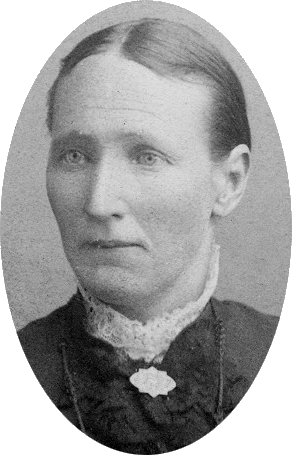Written by Jennette Staples Ericksen and Andrew Madsen

Ane was born in Josoned, Zealand, Denmark on April 2, 1846 [to Ole Lykke Madsen and Ane Jensen]. Her family joined the Church in 1853. Ane was blessed while in Tornved in the Northwest Zealand Branch, May 16, 1853 by Olste P. Neilsen. In 1856 they left Denmark for Zion where they could live their religion in peace (Ole and Ane Jensen and their children Hannah, 16 years (Mrs. Martin Aldrich of Mt. Pleasant), Christena (Steina), 14 years; Marie, 10 years; and myself [Andrew] five years old.
They sailed six or seven weeks and landed in New York with a company of Saints. They had given up their home and all their worldly belongings. They then went from New York to Iowa City, Iowa. There they were to get handcarts, but as the immigrants were unexpected, the handcarts were not prepared, so they had to be built from green lumber.
Handcart standards provided for 17 lbs. of belongings for each adult and 10 lbs. for each child. It was a long, hard trip. They traveled to Winter Quarters (Florence, Nebraska).
They left Winter Quarters in mid August of 1856. When they were in the Rockies between Colorado and Wyoming, winter set in early. They became short of food and warm clothing. The captain put them on short rations. They were allotted a pint of flour a day for each person.
The Company traveled along, tugging and pulling as best they could with their clothing frozen stiff with ice and mud. They became weak so that many died of starvation and many from exposure. Ane would tell of one little girl who tried to eat the flesh from the fingers of their hands. When they cried, she tried to eat her own hands, but the Lord saw fit to take the child.
They really suffered. The snow became so deep. They were so weak from hunger and cold that they could not go on. Andrew says, “My father was one of those who froze to death.” Ole and 12 others were buried in one grave. Each person was wrapped in a piece of a sheet, or anything that could be spared. They were laid side by side or one on top of the other, as best it could be. It was indeed a hard time.
They didn’t cry that morning. The mothers gave the children their portion of food, as they could not eat. That portion was a small scone, about the size of the palm of your hand. They were all frightened, but after getting warm, they were soon asleep.
“Word reached Salt Lake City of our company’s condition.” Brigham Young sent wagons to [bring] them into Salt Lake City. Christena said that some died on the way out of the canyon.
The family arrived in the Great Salt Lake Valley the last of November with no father and a mother having four small children, life was hard. Kind Saints took the children into their homes to work for their board and keep. Ane had to carry water from the creek in two small pails upon a yoke across her shoulders, one on each side. After resting, some of the company went north and some south.
“My mother and her family went to Ephraim, arriving there the latter part of December. There was mother, a widow, with four children; no home, no means. You can’t imagine these things unless you see them or experience them. My mother later became acquainted with Jim Christensen Harbro and married him.“
Some of Johnston’s Army came to Ephraim in the fall of 1857 and stayed all that winter. The coming of this army was a great benefit to the people of Ephraim, as they had plenty of money, and the people found a market for produce.
While a young girl, Ane’s mother, two sisters, and a brother moved with a group of saints to Mt. Pleasant in the spring of 1859. She married Hans Peter Ericksen in Mount Pleasant, Utah, April 4, 1865, and later was sealed in the Manti Temple, 23 May 1899.
It was not an easy life. Hans served as a minute-man fighting Indians during the Black Hawk Indian Wars. When they could leave, they moved to Grand Island, Nebraska to work for the [Union Pacific] Rail Road Co. getting out cord wood and ties.
She helped in the fields and cooked for a group of men that worked for Hans and in the meantime had her family. They worked hard but were very happy in raising their family in their new-found faith.
Then diphtheria came into the family at the time they had seven children. They lost all of them except their son Christian.
Ane died September 3, 1929 in Hamer, Jefferson County, Idaho while living with her son, Leonard. She was sitting at the dinner table and died of an apparent heart attack. She was 83 years old.
Leonard, her youngest son, penned these words of tribute in Hamer, Idaho after visiting Mt. Pleasant for Christmas 1925.

